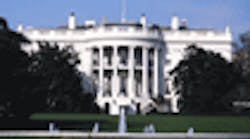In response to pessimistic economic projections for 2008, President Bush today proposed an economic stimulus package potentially valued up to $145 billion to help jump-start the economy. While he did not give specifics on his plan, reports state it could involve shipping a tax rebate worth as much as $800 per individual or $1600 per household as well as a significant amount—up to $50 billion—earmarked for businesses tax relief.
The proposal came after Federal Reserve Chairman Ben Bernanke called for an estimated $100 to $150 billion stimulus package during testimony before Congress yesterday .
“The package must be big enough to make a difference in an economy as large as ours," President Bush said. "By passing a growth package quickly, we can provide a shot in the arm to keep a fundamentally strong economy healthy, and it will help keep economic sectors that are going through adjustments, such as the housing market, from adversely affecting other parts of our economy."
Fed chief Bernanke stressed that despite a lack of growth in the economy, he was not overly concerned about a recession. However, he said a stimulus was necessary to prevent further financial strain.
The Fed Chairman noted problems in the housing market, banks’ reluctance to provide funding, steep oil prices and sluggish investment in equipment and software as major contributors to the economic slowdown. Housing in particular has been a significant factor.
“To date, the largest effects of the financial turmoil appear to have been on the housing market, which, as you know, has deteriorated significantly over the past two years or so,” Bernanke said. “The virtual shutdown of the subprime mortgage market and a widening of spreads on jumbo mortgage loans have further reduced the demand for housing, while foreclosures are adding to the already-elevated inventory of unsold homes. New home sales and housing starts have both fallen by about half from their respective peaks.”
The Fed cut its discount rate by one-half a percentage point on August 17 in an attempt to address short-term money markets. However, Bernanke warned against planning beyond the short-term and added that programs should be only temporary to preclude an increase in the federal deficit. “To be useful, a fiscal stimulus package should be implemented quickly and structured so that its effects on aggregate spending are felt as much as possible within the next twelve months or so,” he said.
Chris Brady, president of Commercial Motor Vehicle Consulting, told Fleet Owner that an economic stimulus package probably wouldn’t have much of a short-term impact on freight. “It may have a long-term effect, but that would probably happen with or without the stimulus,” he explained.
Brady said the Fed is trying to prevent a credit crunch. He pointed out that since assets aren’t worth what they had been and there is a rising number of loan defaults, banks are generally hesitant to make loans to persons right now, whether they have good or bad credit.
“The number of bad loans at banks is increasing,” Brady said. “More people are defaulting, and the Fed doesn’t want them to just get money from the Treasury. They are afraid of a credit crunch. That could ultimately lead to a steep recession. That’s the real risk they see right now.”
While details of the Bush proposal have not been officially announced, it is expected that any such package will draw at least some degree of bipartisan support.
"The acknowledgement by the President today of the immediate need for a stimulus package is significant progress,” said Speaker of the House Nancy Pelosi (D-CA). “In the next few days, through ongoing bipartisan negotiations, we are hopeful that we will agree on legislation that provides timely, targeted, and temporary assistance to America's middle class.”




